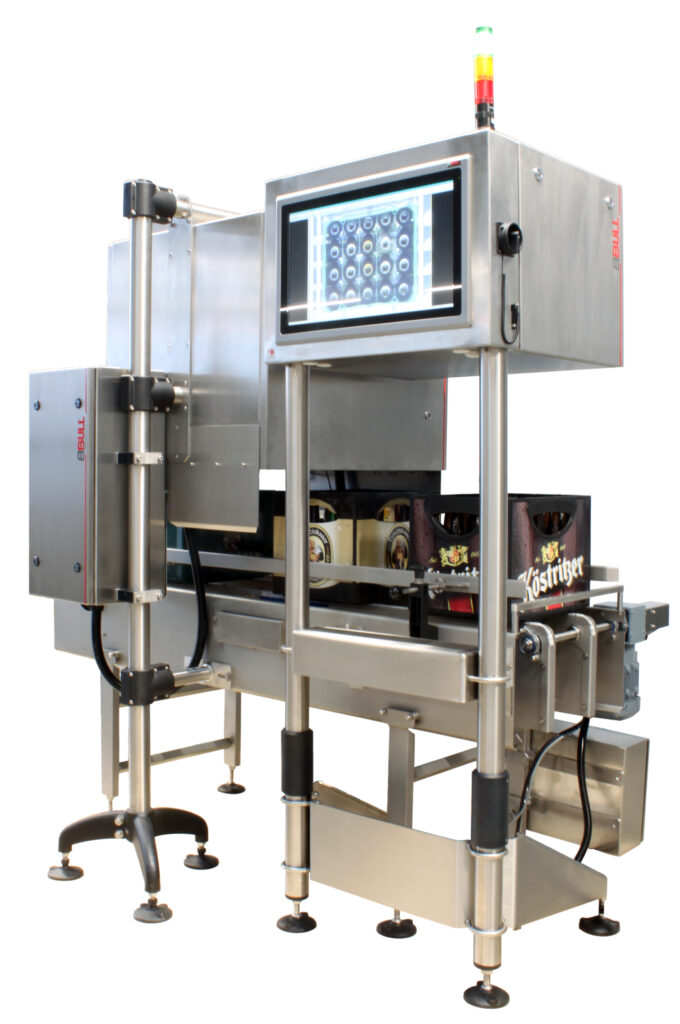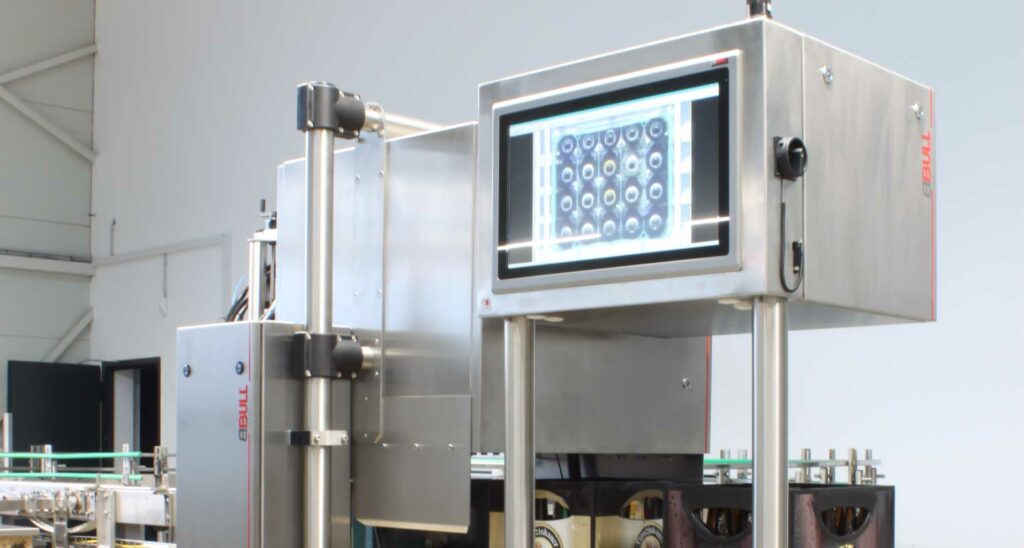Each correct bottle is cash
Not long ago, the Bad Dürrheimer Mineralbrunnen received an innovation award for its 1-liter “Légère” glass bottle with an extra-large mouth. The fountain from the Black Forest fills 60 percent of its waters and sweet drinks in glass bottles. In the case of PET, there are disposable bottles that are shrink-wrapped in multipacks and three different PETCycle bottles that are sold in crates. For these PETCycle containers, the fountain has an agreement with the licensor in Bad Neuenahr, where the deposit is charged to retailers. Bad Dürrheimer, however, is a “net reporter,” which means that all missing bottles or incorrect bottles that come back with the crates are themselves reported to the head office and must therefore be accounted for quite accurately. Only the “correct” bottles with the distinctive octagonal or decagonal neck ring can be accounted for, all others have to be sorted out. For this, the fountain relies on the tried-and-tested Compact LG 500 universal empties management system from the specialist BBull Technology in Königsbach-Stein.
Water from plateau
In 1956, the then mayor and spa director Otto Weissenberger found the best mineral water near Bad Dürrheim, today located in the Schwarzwald-Baar district next to the central town of Villingen-Schwenningen. Two years later, Adelbert Vogt and Klaus Dettling from Freiburg founded the mineral water company “Dürrheimer Johannisquelle Vogt KG”. On May 23, 1959, the first bottle rolled off the production line. The slogan at the time was “Vom Quell her gut” (“Good from the source”). Since then, production capacities have been continuously expanded. More than 120 million bottles are filled annually from seven mineral water springs and one medicinal water spring, all located in the close vicinity of the spa town of Bad Dürrheim. The 150 employees process 60 percent into seven different glass bottles, 40 percent into three different PET cycle bottles (0.5l, 1.0l, and 1.5l), plus 0.75l non-refillable PET. “With the two brands Bad Dürrheimer and Wittmansthaler, three different waters, one medicinal water, and 25 different sweet beverages, we are well positioned. Our sales area is the south of Baden-Württemberg, but our products can also be found in the Rhineland, southern Hesse and the Palatinate. Our sales team is on the road in this region. Our own fleet of 15 modern trucks, as well as contract carriers who have been working for us for many years, take care of deliveries to our customers,” reports the head of maintenance, Jürgen Lauble.
Exact empties detection without X-rays
The PETCycle bottles are blown from the well itself and then filled at a rate of 22,000 bph. The line runs in two shifts in winter and three shifts in summer, so all the machines on the line have to be extremely reliable. “We were looking for a system that could reliably detect empties: crates with missing bottles, glass bottles, or other PET bottles. For billing reasons, we have to be quite sure of detecting the exact number of bottles with octagonal or decagonal neck rings. In addition, we don’t want to have an X-ray source in the entire plant, so this detection system also had to be without radioactive X-rays. And no one but BBull could offer us that!” reports Markus Link, head of the electrical workshop.

The choice then very quickly fell on the universal BBULL 500 “Compact LG” empties management system. It is characterized by a very compact, space-saving design. A measuring bridge is located in a stainless steel housing, which contains a universal ultrasonic line with up to 16 individual sensors. The basic image processing module consists of a color camera and a telecentric optics, this prevents a distortion of the objects with an excellent resolution, so any defects or deviations are detected very reliably. In the higher expansion stage, which is also in use in Bad Dürrheim, two cameras and two different lighting technologies are installed.
Special lighting and optics for bottle type detection
The use of the universal ultrasonic line eliminates the need to adapt the sensors to different crate formats and bottle positions. The activation of the respective sensor information is software-controlled without operator intervention. This minimizes setup times and largely prevents errors caused by incorrect operation. The basic system with a camera and telecentric optics generates an image recording of the entire crate width for each row of bottles. The individual images taken are combined by means of software to form an overall image with true-to-detail reproduction.
The task at the Bad Dürrheimer Mineralbrunnen required the equipment of an additional optical module. This extension module includes an additional camera and an additional LED UV illumination. Both cameras take one image per row of bottles, the first in the daylight spectrum, the second in the ultraviolet range. The individual images generated in this way are combined after the crate has been passed through and examined by the recognition software for the bottle features that can be detected in each case. Each crate is thus examined in two independent images. The different illumination methods can be used to inspect features such as contours, labels, or especially the carrying rings, which are not visible in the basic configuration or are obscured by other features. The low-wear, high-performance LED lighting modules are deliberately installed above the conveyor level and are therefore protected against soiling and damage, which minimizes maintenance.
Exceptional detection software
Outstanding part of the BBull empties management system is the application of the universal image processing software “BBULL IMAGE”. Every single sensor and camera delivers raw data to this software. The height information of the ultrasonic sensors is converted into gray values so that the image processing software generates a three-dimensional image of the container to be examined. Scalable evaluation algorithms are then used to make an assessment of the contents and the box. Here, links and dependencies of different features are adjustable, so that an extremely high detection reliability is given, even under variable conditions. The software contains an extensive database function, which ensures storage and recognition of a wide variety of box types.
Enormous number of features are detected
Up to 7000 crates per hour can be precisely controlled. They enter the system and are stopped for a short moment. A second conveyor then pulls crate by crate, one at a time and with a small gap, and passes them under the measuring bridge. Powerful LEDs in different colors, a dual lighting module and ultrasonic sensors check the crate for a wide range of criteria as it passes through: Foreign objects, lying, broken or upturned bottles, damage or deformation to the crate, is a bottle missing or are one or more “wrong” bottles (made of glass or without the distinctive octagonal or decagonal neck ring) in the crate. It would also be possible to detect the cap or crate label, as well as the crate format and color, but these criteria do not play a role at the mineral water bottling plant. The entire system is controlled by a central operating and processing unit in a stainless steel housing and a logical 13″ touch-screen user interface.
Errors sorted out and fixed manually
All crates with one or more defects are gently transferred by the pneumatic “sinus sorter” to a parallel conveyor for manual defect removal. Incorrect bottles are removed and collected in large bags, after which the crate is placed back into the production flow. “If we’re running liter bottles and 9-bottle crates, then we’re taking out about two big bags of wrong bottles per shift. But if we fill 0.5 (20-bottle crates) or 1.5-liter (6-bottle crates), then there are eight to ten bags in a shift. Every wrong or missing bottle is cash money for us, because we offset the total bottles against the deposit from PETCycle headquarters. That’s why the PETCycle people also took a close look at the BBull machine and declared it to be very good,” reports the head of business administration, Günter Höfler.
Bad Dürrheimer and PETCycle convinced by BBull system
All sorted bags are examined once again, bottle by bottle, at a special sorting center run by a service provider to determine whether they are disposable or reusable deposit bottles. This is then also charged for. “On average, there are between 5 and 8 percent of incorrect bottles in the returned empties – of course, we want to be sure to identify all of these, because otherwise we’d pay on top! After all, each of our bottles has a deposit value of 25 cents,” says Markus Link. According to him, BBull’s empties management system exactly meets the specifications the fountain had. “The system is very logically designed and easy to operate; during our regular tests with prepared bottles and crates, we see very clearly that all faults are detected and safely rejected. We tested the machine for a few months and have now fully adopted it – it’s the perfect solution for us!”

